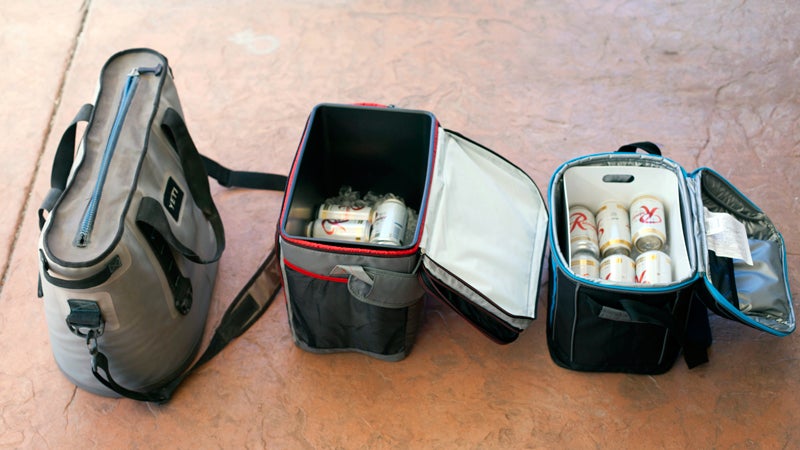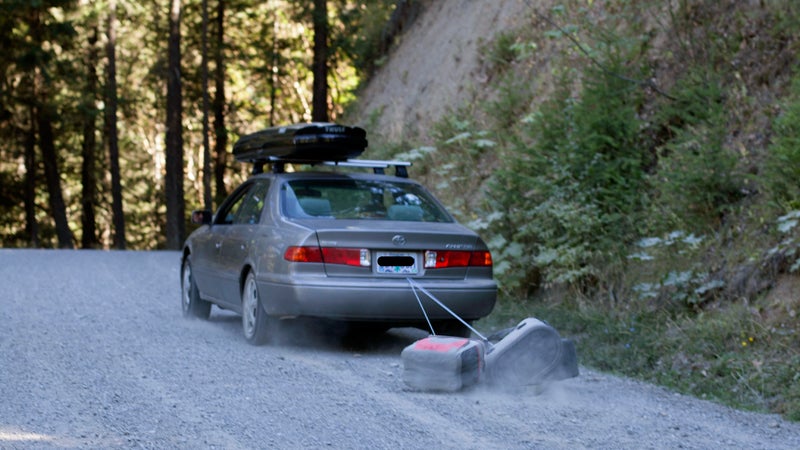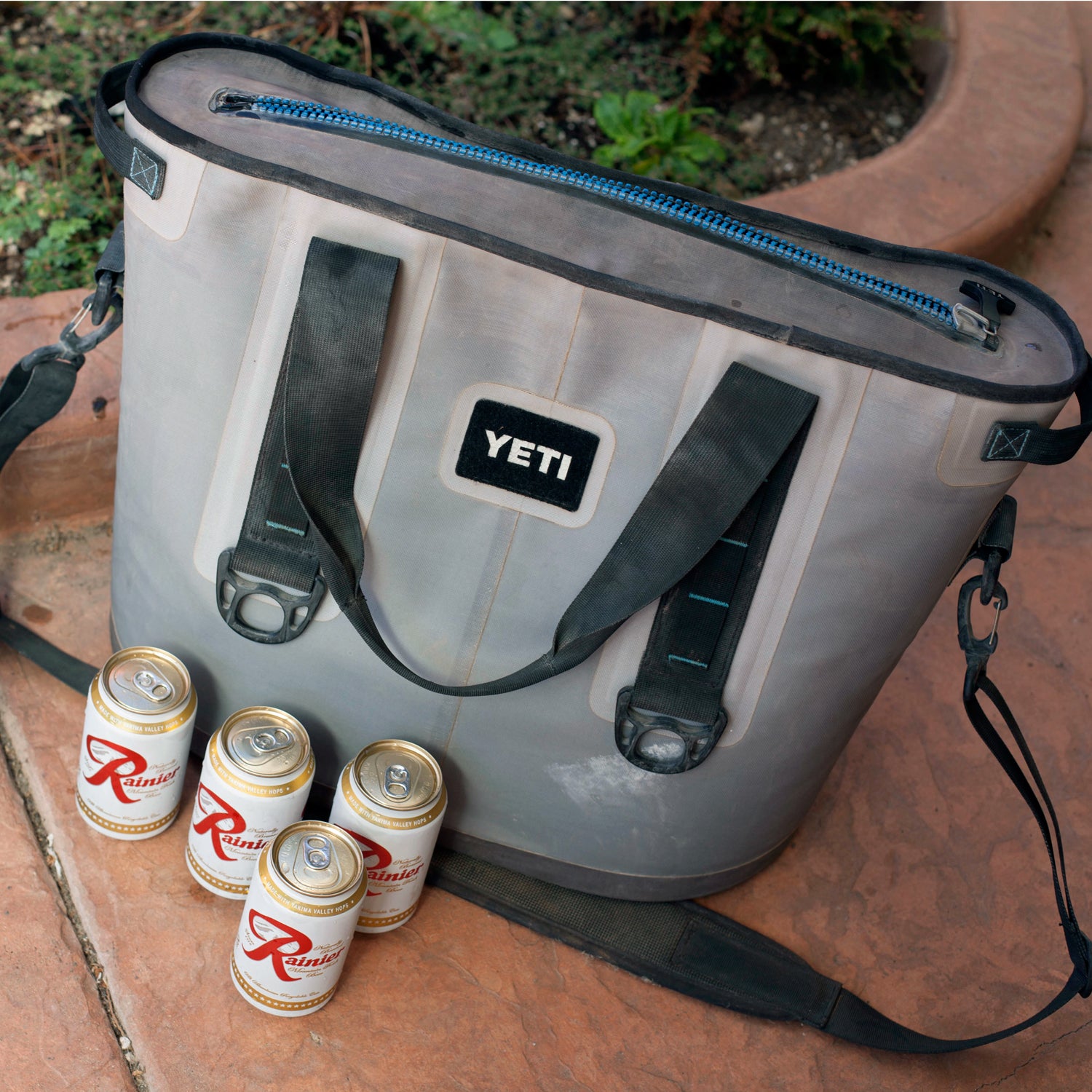When we covered the debut of Yeti Coolers’ $300 Hopper in July, many of our readers took issue with the soft-shell cooler’s lofty price tag.
We get it. After all, you can pick up a soft-sided cooler for . But the Hopper is a Yeti, and it comes from a company that has built an empire around expensive—and genuinely amazing—hard-shell coolers. If anyone could make a soft-shell cooler to rival a hard-shell icebox intended for expeditions, it’s Yeti.
I’ve tested the for two months—including a 16-day trip down the Grand Canyon—to determine whether it lives up to its roto-molded forebearers. I dragged it behind my car at 20 mph to test its durability, and I pitted it head-to-head against two cheap soft-shell coolers: ($18) and a ($21).

Here's how it stacked up:
Thermal Regulation
The Test: I filled the 6.5-gallon Hopper, the Ozark Trail, and the Coleman 30 with a six-pack of 50-degree Rainiers and seven pounds of ice each. I then checked the beer temperature after six hours in the sun on a 75-degree day and again after 24 hours. I also measured the amount of ice left after a full day.
Note: While I did use a thermometer to check the beer temperature and a scale to gauge ice content, I wouldn’t call this experiment scientific. For starters, the coolers were different sizes, meaning they’ll retain ice differently.
I also didn’t use Yeti’s recommended two-to-one ice-to-beer ratio—I had 4.8 pounds of beer to seven pounds of ice. Why? I wanted to see if the Hopper blasted the cheap coolers out of the park when filled with the same amount of ice and beer.
The Result: After six hours, the beer in the Hopper was 38 degrees—one degree colder than the beer in the Ozark and five degrees colder than the Coleman.
After 24 hours, the Yeti still had almost a pound of ice. The Ozark Trail and the Coleman, on the other hand, had no ice left. After the 24-hour test, the beer in the Yeti was still quite cold (39 degrees). Compare that to the beer in the Ozark Trail (47 degrees) and the Coleman (50 degrees).
So while the Yeti did outperform the other two, I wasn’t blown away by its ability to keep beer cold. It’s certainly not on par with the company’s hard-shell coolers, which, based on my past experience, would have kept up to 75 percent of the ice over 24 hours.
I should also note the Hopper was, as advertised, 100 percent leakproof. Water couldn’t get in or out of the cooler once the Hydrolock zipper was closed. The other two coolers leaked like sieves along their zippers, although, to be fair, neither was billed as leakproof.
Durability
The Test: The Hopper served as the everyday beer-soda-and-snack cooler on my buddy’s 16-day raft trip on the Grand. It was tightly strapped to the raft’s oar frame and de-rigged every day.
When I got the cooler back, I took the durability test one step further. I dragged the Yeti, the Ozark Trail, and the Coleman behind my car for three miles on gravel roads at speeds up to 20 mph. I checked on the coolers every half mile.

The Result: After the Grand Canyon trip, I found that the Hopper’s six D-rings withstood the constant wrenching and torsional stress of life on a raft in big-water rapids extremely well. The Hopper showed up no worse for wear—not even scratches on the D-rings.
I was also very impressed by how well the Yeti’s Dryhide shell stood up to the car torture test. The Ozark Trail disintegrated after the first half mile, while the Coleman lasted two miles before falling apart. The Hopper, on the other hand, had only minor scuffs on two of the D-rings and two-inch-long, millimeter-thick abrasions after three miles behind the car: Nothing to prevent it from keeping contents cold.
Portability and Packability
People buy soft-shell coolers because they’re lighter and easier (and often cheaper) to pack than their hard-shell counterparts. The five-pound Hopper is no exception. It wasn’t a hazard on the moving raft (especially important for boaters with children), and it was easy to stuff into tight corners (depending on contents).
You can also throw it over your shoulder and comfortably hike a decent distance (depending on your fitness level)—not an option for most hard coolers in this size range.
Access
The Hopper’s Hydrolock zipper is similar to what you’ll find on waterproof drysuits, making the cooler leakproof and insanely durable. But the zipper is also stiff and tends to push the opening closed even when unzipped. Result: It can be tricky to get large items like a big bag of grapes in and out of the cooler, and the zipper had a tendency to snag arm hairs even when I was just grabbing a single beer.
The small opening also made this cooler difficult to clean because it was hard to dump water and get an arm in there to scrub.
Bottom Line
The Yeti Hopper thermoregulates incredibly well for a soft-shell cooler. It is also about 10 times more expensive than most soft coolers on the market. Does it thermoregulate 10 times better than its cheap counterparts? No. Is it 10 times more durable? Absolutely.
The Hopper’s strengths lie in its durability, packability, and portability. I can confidently say that it's superior to any soft-sided cooler on the market when it comes to these three traits. And when it comes to packability and portability, it also has hard-shell coolers beat.
So, the $300 question: Is it worth the money? If you value durability and quality construction and need a soft-shell cooler to add to your roto-molded quiver, go with the Hopper. We’re thinking fly fishermen, paddlers, raft guides, and hunters who want a packable, lightweight cooler that’ll last forever despite seasons of abuse.
If you just need a cooler for the occasional picnic, car-camping trip, or trip to the beach, save your money and go with a $25 option.


